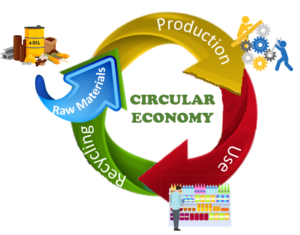This is the fourth in a series of posts about entrepreneurs. I’d like to begin this post with the story of an Italian who went from winemaker to shoemaker and how that happened [“A Hole-in-One Idea,” by Elizabeth Garone, Wall Street Journal, 9 February 2010]. Garone reports:
“In 1992, Mario Polegato was busy overseeing Villa Sandi, his family’s third-generation winemaking business in Italy’s Treviso region. While attending a wine convention in Reno, Nev., he decided to get some fresh air and go for a walk. ‘As soon as I stepped out in the desert heat, my feet started to suffer as the rubber sole did not let the heat escape from my shoes,’ he says. He took out his Swiss Army knife and cut holes in the soles of both shoes. ‘I could immediately feel a difference,’ he recalls. Mr. Polegato had created a crude prototype for a shoe technology he would perfect back in Italy—one that would eventually launch a now billion-dollar company.”
In past posts about entrepreneurs, I’ve noted that they are naturally curious. They ask questions when things don’t seem right. Polegato, for example, wondered whether his feet would be cooler if he cut holes in the bottom of his shoes. Not many people I know would have ruined a pair of shoes so that they could take a walk on the hot pavement of Reno, Nevada; but that’s my point — entrepreneurs are not like most people. Once Mr. Polegato had altered his shoes and felt the effect, his mind kept churning and he saw possibilities in the already crowded foot apparel industry. Garone continues his story:
“‘I started to work with local universities, and after years of research we created the Geox technology,’ he says. While most shoes hold sweat in, Geox shoes let the foot breathe via a perforated sole and a porous membrane Mr. Polegato designed with the goal of keeping dirt and water out. ‘When we sweat inside our shoes, we produce vapor, which can be released through the membrane and the outsole,’ he explains. The idea is to keep feet dry and at the right temperature.”

As the above image shows, the holes are small and recessed, but they are there. Garone continues the tale of winemaker turned shoemaker:
“Initially, Mr. Polegato tried to interest large footwear companies in his concept, including Nike, Puma, and Adidas. ‘They turned down my idea,’ he says. ‘They found it strange that I was promoting holes in shoes.’ So, Mr. Polegato decided to go it alone and, in 1995, he founded Geox with a bank loan, not wanting to use his family money. He left the family wine business—which produces 22 million bottles a year—in the hands of his younger brother, Giancarlo. ‘When you really believe in a project, you will do it, even if you have to do it alone,’ he says. The company started small, with a handful of managers. The real marketing started as the shoe began to gain traction.”
Because the sole was designed to reduce heat and moisture, athletic shoes probably seemed like a natural market. Visit the Geox web site, however, and you will see a range of shoes, many of them dress or casual rather than athletic shoes. Although Polegato’s story up to that point is fascinating, what Garone writes next fascinated me just as much.
“Mr. Polegato faced one hurdle he is still working to change: Italians are known for their good ideas, but haven’t always followed through, he says. ‘Think of espresso coffee or pizza, think of Starbucks and Pizza Hut: Italian creativity and American business,’ he says. To combat that, he launched an in-house school for employees, with a different course each year in everything from retail management to product design. Today, Geox produces more than 20 million pairs of shoes each year and they are sold in 100 countries. Sales were up 16% in 2008 to $1.3 billion, although company officials said in November they expected 2009 revenue (figures will be released February 26) to drop 3% to 5% from the year before due to the global recession. The company counts Pope Benedict XVI and Paul McCartney as customers.”
In bad times, employee training always seems to be one of the first ways that companies cut back. Often, that decision is short-sighted. Mr. Polegato’s willingness to invest in his employees as well as invest in his products singles him out as a true visionary. Go buy a pair of shoes and see if he got it right! As I’ve pointed out time and again, not everyone has the right stuff to become a successful entrepreneur. Luke Johnson, chairman of the Royal Society of Arts in Britain and who runs Risk Capital Partners (a private equity firm) and frequent columnist for the Financial Times, discusses why he became a supporter of entrepreneurs rather than an entrepreneur himself [“Start-ups with a dash of going concern,” 12 January 2010]. He begins his column by asking the big question: “Shall I find an acquisition or do a start-up?” He continues:
“This is the first great question confronting anyone who wants to run their own business. If you buy a going concern, you should inherit existing customers, staff, contracts, premises, suppliers, products, brands and goodwill. All these vital elements can take years to assemble from scratch – and you may stumble on the way, possibly fatally. The certainty and swiftness that come from taking over a project that already has momentum is worth a great deal. In 1980 Bill Gates wanted an operating system for IBM personal computers in a hurry. So he purchased, for $75,000, exclusive rights to existing software, rebranded it as a Microsoft product and resold it to IBM. It became MS-DOS, the forerunner of Windows, and the basis of the largest fortune in the world.”
Just to expand a bit on the Bill Gates story, MS-DOS was a renamed form of 86-DOS that was owned by Seattle Computer Products and written by Tim Paterson. What happened to Mr. Paterson? According to Wikipedia:
“Paterson left SCP in April 1981 and worked for Microsoft from May 1981 to April 1982. After a brief second stint with SCP, Paterson started his own company, Falcon Technology, which was bought by Microsoft in 1986. Paterson did a second stint with Microsoft from 1986-1988 and a third stint from 1990-1998. During his third stint at Microsoft, he worked on Visual Basic. After leaving Microsoft a third time, Paterson founded another software development company, Paterson Technology, and also made several appearances on the Comedy Central television program Battlebots. Paterson also races rally cars in the SCCA Pro Rally series, and even engineered his own trip computer which he integrated into the axle of a four-wheel drive Porsche 911.”
He may not have become as rich as Bill Gates, but he seems to being fine. Back to Johnson’s article.
“Buyers pay a premium for established revenues, proved technology – and sometimes an opportunity that the founders of a business lack the vision or the ambition to see. Ray Kroc sold equipment to the McDonald brothers in their single Californian hamburger restaurant. He understood what a fabulous formula they had developed and franchised the concept elsewhere. A few years later he bought them out for $2.7m. Before long his purchase was worth billions – built on their brainchild and his execution.”
What Gates and late Ray Kroc share in common with other entrepreneurs is a vision of the possible. They see opportunities beyond those immediately evident. Johnson continues:
“Too often would-be entrepreneurs tell me they lack the capital to buy a business. But my experience has been that if you find a good enough deal, the funds will flow. You need a degree of credibility – and persistence – but the world is actually awash with capital looking for a decent return. And raising backing for an up-and-running venture is normally easier than for an entirely novel project. Veteran angels know the road to achievement is paved with defeated attempts.”
What I believe Johnson is saying is that just because someone buys a business in which they see opportunity they shouldn’t be pushed out of the spotlight with other entrepreneurs. I’m not talking about someone who buys a franchise, I’m talking about someone who buys a business and turns it into an entirely different creature like Gates and Kroc. Johnson realizes, however, that buying someone else’s idea and expanding on it might not scratch the true innovator’s itch. He continues:
“Purchasing another’s invention does not necessarily satisfy a desire to be a genuine innovator. As Nikola Tesla, the inventor, said: ‘I do not think there is any thrill that can go through the human heart like that felt by the inventor as he sees some creation of the brain unfolding to success … Such emotions can make a man forget food, sleep, friends, love, everything.’ There is unquestionably a sense of purpose and passion that business founders have that is formidable to behold. And without such brilliant romantics, society would not advance.”
In calling Tesla a brilliant romantic, Johnson hints at the fact that Tesla died broke. Only in recent times has the name Tesla become something mystical and marketable. Johnson reminds us that not all good ideas make money.
“As they say, pioneers die broke. Many progenitors of groundbreaking schemes fail to reap the rewards of their imagination. Charles Goodyear, popularly known as the inventor of the rubber tyre, only received the honour of having the famous company named after him – and that was some 40 years after his death.”
Speaking for himself, Johnson explains why he decided to become a supporter of entrepreneurs rather than remain an entrepreneur himself. He concludes:
“I realise that I tend to lack the originality and obsessive temperament so common in entrepreneurs who feel compelled to build start-ups. So I aim to partner with them or invest in companies that have survived the risky early years. Perhaps I am lazy, impatient or just unsentimental. I suppose experience has made me somewhat cynical. I have witnessed or lost money in so many great ideas that came to nothing that I know every new enterprise is a long shot – whatever the business plan says. Yet finding something to buy and agreeing satisfactory terms with the vendor is never easy. You end up making all sorts of compromises, whereas if you commence with a blank sheet of paper you can compose your own dream. And you can always, on the journey, buy a business to add to your start-up. My concession is to find assets where much has been done but there remains much to do – they offer reasonable odds but also a sense of exhilaration.”
Whether you are entrepreneur that starts a business from scratch or one that builds on an established idea of someone else, you can make your business better by remaining curious and having an open mind to the ideas of others. Teri Evans writes about some entrepreneurs who make the solicitation of ideas from their employees an important part of their business [“Entrepreneurs Seek Ways to Draw Out Workers’ Ideas,” Wall Street Journal, 21 December 2009]. She writes:
“When Andrew Schuman bought Hammond’s Candies in 2007, the nearly 90-year-old candy company was operating in the red. Mr. Schuman, who says he knew nothing about the candy business, soon learned that an assembly-line worker, rather than an executive, had dreamed up the design of the company’s popular ribbon snowflake candy. It was an ‘aha’ moment, he says. ‘I thought, “wow, we have a lot of smart people back here, and we’re not tapping their knowledge.”‘ So last year Mr. Schuman decided to offer a $50 bonus to assembly-line workers who came up with successful ideas to cut manufacturing costs. ‘They’re the ones making and packing the candy, so I thought they probably know how to do things better and more efficiently,’ says Mr. Schuman, president of the Denver, Colo., company, which has about 90 employees. The informal idea program, which is open to all Hammond’s Candies workers, has handed out more than $500 in employee bonuses since it began last year. One worker suggested a tweak in a machine gear that reduced workers needed on an assembly line to four from five. Another employee devised a new way to protect candy canes while en route to stores, which resulted in a 4% reduction in breakage. ‘It’s these little tiny things that someone notices that help us in the long run,’ says Mr. Schuman, who adds that the company was able to earn a profit this year.”
Suggestion boxes have been around for a long time. As the old Bible verse states, “What has been will be again, what has been done will be done again; there is nothing new under the sun.” [Ecclesiastes 1:9-14 NIV] The fact that Schuman has paid out pocket change ($500) for new ideas isn’t really the point that Evans is trying to make. By offering rewards for ideas (even if the rewards are small), Mr. Schuman has managed to accomplish two things. First, it gives him an opportunity to praise assembly line workers who probably received scant praise previously for their hard work. Second, and more importantly, he gave his workers a stake in the company’s future by instilling in them a sense of ownership for the work they do. Evans continues:
“As more entrepreneurs turn to employees for innovation to gain even the slightest advantage in a still-sluggish economy, many are discovering the usefulness of cash incentives or other rewards to encourage workers to come forward with ideas. Particularly for small businesses with limited resources, it’s a relatively cheap way to gather ‘lots of ideas and get people proactively thinking about what would make the product, service or company better,’ says David Hsu, entrepreneurship professor at the University of Pennsylvania’s Wharton School. Mike Hall, chief executive of Borrego Solar Systems in San Diego, introduced two quarterly employee contests this year, each with a $500 prize. Beyond the competition, the company’s 55 employees are rated on innovation in their annual reviews. One contest seeks the best business innovation, which Mr. Hall says must be formalized on paper to include the problem the idea solves, as well as its costs, risks and benefits. The other competition rewards the best ‘knowledge brief,’ which requires employees to share valuable information that can benefit the company as a whole. For example, one worker won for creating a glossary of acronyms in the solar industry. ‘It accentuates the importance of disseminating knowledge and trying not to hold it in silos,’ Mr. Hall says. Winners are determined by a companywide secret ballot.”
In the past I’ve written about the dangers of silo thinking (see, for example, my post entitled The Curse of Silo Thinking). I like the fact that Hall lets employees vote on who should win the prizes. Once again it makes them a part of the process, exposes them to the new ideas (which could spur other ideas), and provides open praise for workers doing a good job. Evans continues:
“Prof. Hsu says finding unique ways to reward employees for their ideas is a way to foster esprit de corps. ‘It’s why a lot of people work for small businesses in the first place; there’s a closer connection in the effort they put forward and the final product,’ Prof. Hsu says. Jared Heyman, founder of Infosurv, a market-research firm in Atlanta, says his company has long turned to employees for business ideas. ‘In every industry, as soon as one company creates an innovation everyone else is then playing catchup,’ he says. Five years ago, Mr. Heyman began awarding a $150 restaurant gift card every quarter to the employee with the best business idea. One employee won for developing a technology innovation that helped the company retain a major client that was about to jump ship. ‘The [ideas] program has paid for itself a thousand times over,’ Mr. Heyman says. ‘In terms of cost savings, revenue enhancement and efficiencies, it’s certainly in the six-figure range.’ This year, he upped the ante with a second contest in which the company’s 15 employees must come up with a total of 100 innovative ideas by year’s end to each receive a $100 reward. ‘I think a lot of folks are motivated by the fact that if we fall short nobody wins anything,’ Mr. Heyman says. ‘It reminds everybody that we work together and we’ll succeed or fail together.'”
I’m sure that many entrepreneurs who had brilliant ideas went down in flames because they weren’t willing to listen to the people around them. As John Ruskin, an English art critic and social thinker, stated, “In general, pride is at the bottom of all great mistakes.” Although entrepreneurs must have enormous confidence in their abilities, they must temper self-esteem with a little humility if they are to succeed. A successful entrepreneur recognizes a good idea whether it’s his or her own or whether it comes from someone around them. Remember that Mr. Polegato didn’t rush out and create his own breathable sole; he went to local universities and sought out the ideas of others to make his own idea better. That’s a good lesson for anyone desiring to be an entrepreneur.




